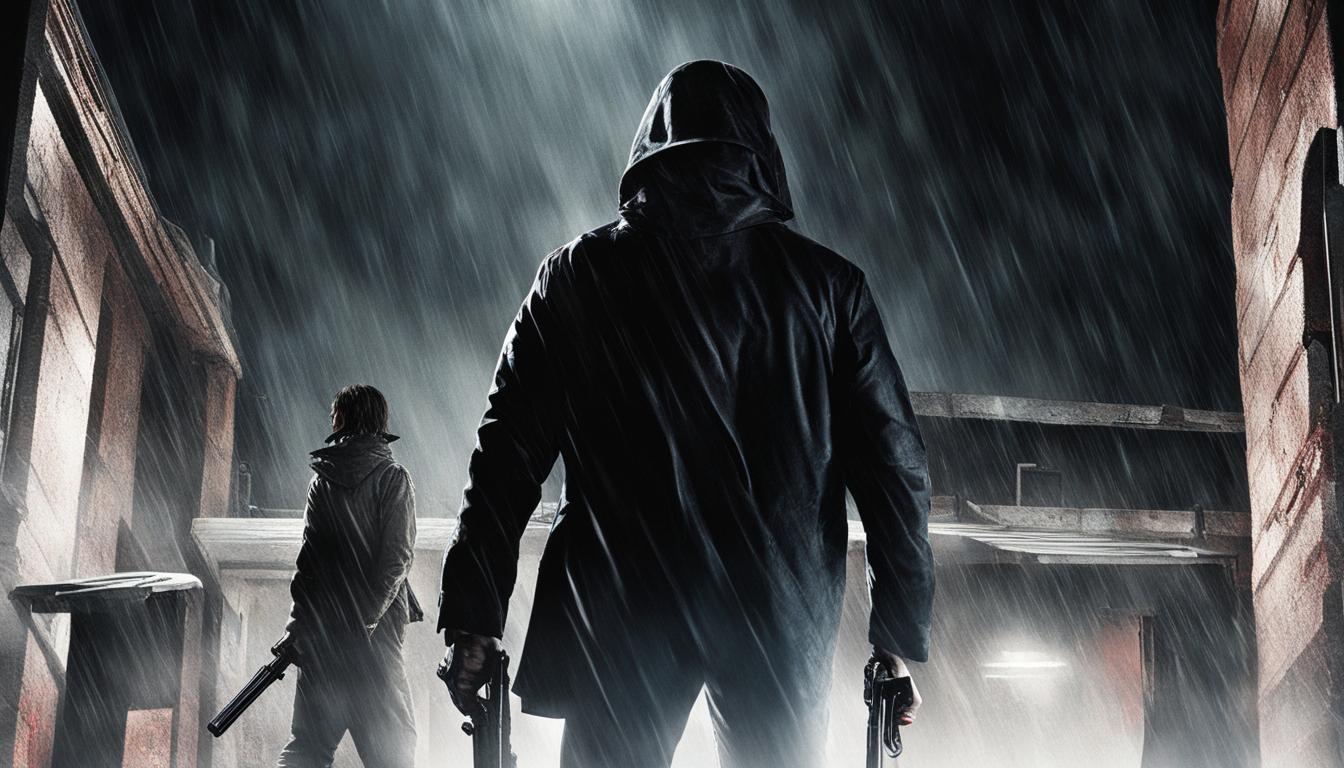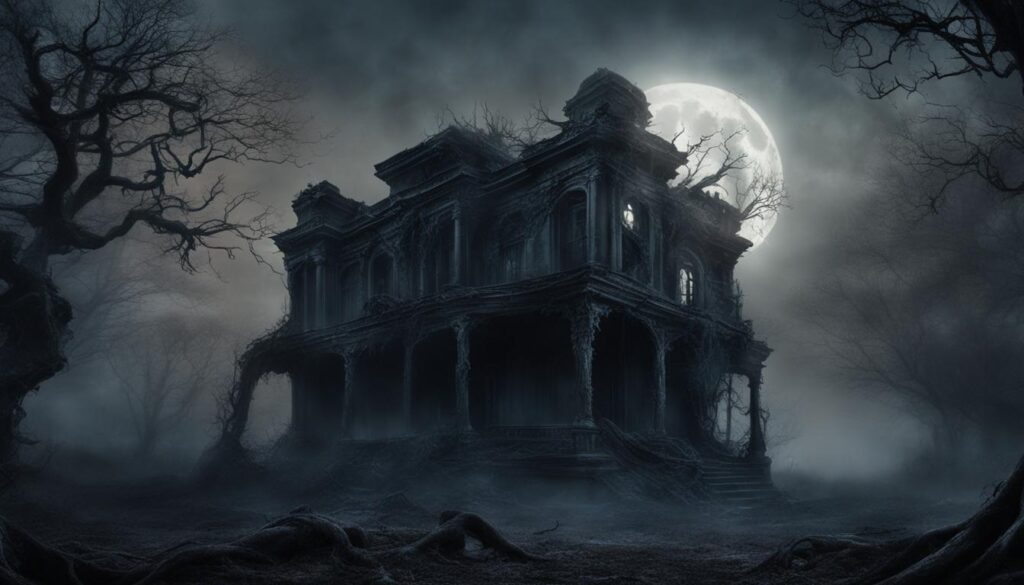The thriller vs horror distinction has long intrigued film enthusiasts. While both genres provide suspense and thrills, they differ in their approaches and themes. Thrillers often focus on psychological suspense, plot twists, and high-stakes action, while horror movies delve into supernatural elements, gore, and the exploration of primal fears. Understanding the nuances between the two genres can help viewers choose movies that align with their preferences.
Key Takeaways:
- The thriller genre emphasizes psychological suspense and plot twists.
- Horror films explore supernatural elements, fear, and gore.
- Thriller vs horror movies often blur the line between the two genres.
- Some movies combine psychological thrillers and supernatural horror.
- Thrillers and horror films have had a significant impact on pop culture.
The Elements of the Thriller Genre
The thriller genre is a captivating and suspenseful genre that keeps viewers on the edge of their seats. It is characterized by its emphasis on psychological suspense and plot twists, making it an intriguing choice for those seeking thrilling and unpredictable storytelling. In psychological thrillers, the focus is often on the complex inner workings of the characters’ minds, exploring their motivations, and their struggle between good and evil.
One of the defining features of the thriller genre is its masterful use of plot twists. These unexpected turns in the narrative can subvert audience expectations, challenge preconceived notions, and reveal hidden truths. They keep viewers engaged and constantly guessing, creating an exhilarating and unpredictable viewing experience. Some notable examples of thriller plot twists include the iconic ending of “The Usual Suspects,” the shocking reveal in “Fight Club,” and the mind-bending twist in “The Prestige.”
Psychological thrillers are known for their ability to immerse viewers in a world of suspense and intrigue. The combination of gripping storytelling, intricate character development, and unexpected plot twists makes them a favorite among film enthusiasts. Notable examples of psychological thrillers include “Gone Girl,” “The Silence of the Lambs,” and “Shutter Island.” These films showcase the elements that define the thriller genre and highlight the talent and creativity of filmmakers in delivering captivating and suspenseful narratives.
| Movie | Plot Twist |
|---|---|
| Gone Girl | The reveal of Amy’s true intentions |
| The Silence of the Lambs | The identity of the killer, Buffalo Bill |
| Shutter Island | Protagonist’s identity and the nature of the institution |
Overall, the thriller genre offers audiences an exciting and unpredictable ride filled with psychological suspense and thrilling plot twists. Whether it’s immersing viewers in the complex minds of characters or leading them through a web of unexpected turns, thrillers continue to captivate and entertain audiences around the world.
The Elements of the Horror Genre
When it comes to the horror genre, supernatural elements, fear, and gore take center stage. These films tap into our primal fears and explore the darker side of human existence. From supernatural entities to ghosts, monsters, and serial killers, horror movies introduce audiences to the most terrifying creatures and scenarios imaginable.
One of the key techniques used in horror films is the jump scare. These sudden and unexpected scares startle viewers, creating a sense of tension and unease. In addition, the use of a tense atmosphere, graphic violence, and eerie sound design further enhances the horror experience. These elements work together to elicit strong emotional responses and keep audiences on the edge of their seats.
Supernatural Horror
“Horror movies allow us to confront our deepest fears in a controlled environment, providing a thrilling and cathartic experience.” – Horror enthusiast
Supernatural horror is a subgenre of horror that focuses on the supernatural world and the unknown. These films often involve haunted houses, demonic possession, and ancient curses. They play on our fear of the supernatural and offer a glimpse into a realm beyond our understanding.
Some notable examples of supernatural horror films include “The Exorcist,” which portrays the terrifying effects of demonic possession, and “The Ring,” which explores the horrors unleashed by a cursed videotape. These movies captivate audiences with their haunting visuals and spine-chilling storylines.
| Elements of the Horror Genre | Examples |
|---|---|
| Supernatural Entities | “The Exorcist,” “The Conjuring” |
| Jump Scares | “The Babadook,” “Insidious” |
| Tense Atmosphere | “The Shining,” “Hereditary” |
| Graphic Violence | “Saw,” “Hostel” |
The horror genre continues to evolve and push boundaries, with filmmakers constantly finding new ways to terrify and captivate audiences. Whether it’s through supernatural elements, jump scares, or creating a tense atmosphere, horror films provide a unique and thrilling viewing experience.
Popular Examples of Thriller vs Horror Movies
When it comes to thriller vs horror movies, there are several films that blur the lines between the two genres, creating a unique blend of suspense and terror. These movies challenge traditional genre conventions and provide audiences with an unsettling and thrilling cinematic experience.
One popular example is “The Sixth Sense,” directed by M. Night Shyamalan. This film combines elements of psychological suspense and supernatural horror. With its unexpected twists and eerie atmosphere, it keeps viewers on the edge of their seats until the very end.
“Get Out,” directed by Jordan Peele, is another film that defies genre boundaries. This movie seamlessly weaves together social commentary, psychological suspense, and horror elements. It explores themes of racism and identity, making it both thought-provoking and chilling.
“Split,” directed by M. Night Shyamalan, is a psychological thriller that delves into the mind of a man with multiple personalities. It ramps up the tension and keeps audiences guessing with its unpredictable plot twists and intense performances.
Table: Thriller vs Horror Movies
| Movie | Genre | Director |
|---|---|---|
| The Sixth Sense | Thriller / Horror | M. Night Shyamalan |
| Get Out | Thriller / Horror | Jordan Peele |
| Split | Thriller | M. Night Shyamalan |
Genres That Cross Over
When it comes to storytelling, sometimes boundaries are meant to be broken. This is certainly the case in the world of cinema, where genres often blend together to create unique and compelling narratives. One such crossover is between psychological thrillers and supernatural horror. These movies combine the intense character-driven narratives and psychological suspense of thrillers with the supernatural or horror elements that evoke fear in viewers. The result is a captivating and immersive viewing experience that keeps audiences on the edge of their seats.
Examples of psychological thrillers that incorporate supernatural or horror elements include “The Shining,” “A Quiet Place,” and “The Ring.” In “The Shining,” director Stanley Kubrick masterfully blends psychological torment with supernatural elements, creating an unsettling atmosphere that lingers long after the credits roll. “A Quiet Place” takes the concept of a psychological thriller and infuses it with the terror of a post-apocalyptic world overrun by creatures that hunt by sound. “The Ring” combines elements of a psychological thriller with the supernatural, as a cursed videotape haunts those who watch it.
What makes these crossovers so intriguing is the way they subvert expectations and challenge the conventions of their respective genres. They offer a unique blend of psychological suspense, intense character development, and spine-chilling horror, making them a favorite among audiences who appreciate the nuances of both genres. Whether you’re drawn to the mind games of a psychological thriller or the supernatural scares of a horror film, these crossovers provide the best of both worlds, delivering a truly unforgettable cinematic experience.
Table: Psychological Thrillers vs Supernatural Horror
| Psychological Thrillers | Supernatural Horror |
|---|---|
| Focus on psychological suspense | Explore supernatural elements |
| Intense character-driven narratives | Evoke fear through supernatural entities |
| Twist endings and unexpected turns | Jump scares and tense atmosphere |
| Delve into the human psyche | Tap into primal fears |
As the table illustrates, while psychological thrillers focus on psychological suspense and plot twists, supernatural horror movies delve into supernatural elements and the exploration of primal fears. These crossovers provide a unique and thrilling blend of both genres, offering a rich and multifaceted viewing experience for fans of psychological suspense and supernatural horror alike.
Techniques of Horror Suspense
Horror films are masterful at building suspense and evoking feelings of fear and unease in viewers. Through the use of various techniques, these movies create an atmosphere of dread that keeps audiences on the edge of their seats. From atmospheric cinematography to expert pacing, horror suspense techniques are designed to heighten the emotional impact of the film and deliver spine-chilling experiences.
One of the key techniques employed in horror films is atmospheric cinematography. Through the careful use of lighting, shadows, and camera angles, directors create a sense of unease and foreboding. Dark, claustrophobic settings and eerie, dimly lit environments contribute to the overall atmosphere of the film. These visual elements work together to build tension and create a sense of impending doom.
The sound design in horror films is another crucial aspect that enhances suspense. Creepy, discordant music and unsettling sound effects can make even the simplest scenes feel eerie and unnerving. Sound is often used to foreshadow scares or create an ominous mood, heightening the sense of anticipation in viewers. A well-crafted soundtrack can effectively manipulate emotions and intensify the horror experience.
Tension and anticipation play a significant role in horror suspense. Filmmakers skillfully use pacing to create a feeling of rising tension, gradually building towards moments of terror. Lengthy, slow-paced scenes can instill a sense of unease, while sudden bursts of frenetic action can startle and shock the audience. By carefully controlling the pace, horror films manipulate the viewer’s emotions and amplify the impact of frightening moments.
Table: Techniques of Horror Suspense
| Technique | Description |
|---|---|
| Atmospheric Cinematography | Creates a sense of unease and foreboding through lighting, shadows, and camera angles. |
| Sound Design | Utilizes creepy music and unsettling sound effects to enhance suspense and create an ominous mood. |
| Tension and Anticipation | Controls pacing to gradually build tension and create a sense of rising anticipation. |
“Horror films rely on the art of suggestion. It’s what you don’t see that terrifies you the most.”
The combination of these techniques, along with others not mentioned here, contributes to the effectiveness of horror suspense in films. By manipulating cinematography, sound design, and pacing, horror movies create an immersive experience that keeps viewers engrossed and captivated. Whether it’s the slow build-up of tension or the sudden shock of a jump scare, these techniques work together to deliver the spine-tingling thrills that horror enthusiasts crave.
The Elements of the Thriller Genre
The thriller genre is known for its captivating plot twists and intense psychological suspense. These films keep viewers on the edge of their seats, constantly questioning what will happen next. With their intricate narratives and unexpected turns, thrillers have become a favorite among movie enthusiasts.
In psychological thrillers, the emphasis is on exploring the inner workings of complex characters. These films delve into their motivations, moral dilemmas, and the constant struggle between good and evil. The plot twists in thrillers are designed to subvert expectations, challenge preconceived notions, and reveal hidden truths. These unexpected turns often leave audiences stunned, reevaluating everything they thought they knew about the story.
Notable examples of thriller plot twists include the iconic ending of “The Usual Suspects,” where the true identity of the criminal mastermind is revealed, and the twist in “The Prestige,” which unravels the mystery behind the magician’s illusions. These plot twists add layers of complexity to the narrative, elevating the overall viewing experience and leaving a lasting impression on the audience.
Thriller Plot Twists in Psychological Thrillers
Psychological thrillers, in particular, excel in crafting intricate plot twists that keep viewers engaged and guessing until the very end. These films often play with the audience’s perceptions, leading them down one path before revealing a shocking twist that completely changes the narrative.
One notable example of a psychological thriller with a mind-bending plot twist is “Fight Club.” Throughout the film, the audience is led to believe that the main character, played by Edward Norton, is merely suffering from insomnia and has created an alter ego, Tyler Durden, as an outlet for his frustrations. However, the twist reveals that Tyler Durden is actually a figment of the main character’s imagination, serving as a manifestation of his own repressed desires.
Another psychological thriller that masterfully utilizes plot twists is “Shutter Island.” The film follows U.S. Marshal Teddy Daniels, played by Leonardo DiCaprio, as he investigates the disappearance of a patient at a psychiatric institution. As the story unfolds, the audience is led to believe that Teddy is an outsider trying to solve the mystery. However, the twist reveals that Teddy is actually a patient himself, a former violent criminal who created an elaborate delusion to cope with his guilt.
| Film | Plot Twist | Impact |
|---|---|---|
| The Usual Suspects | The reveal of Keyser Söze’s true identity | Leaves audiences stunned and reevaluating the entire film |
| The Prestige | The revelation of the secret twin | Enhances the complexity of the story and adds layers of intrigue |
| Fight Club | The reveal that Tyler Durden is a figment of the main character’s imagination | Completely changes the audience’s perspective on the events of the film |
| Shutter Island | The revelation that Teddy Daniels is a patient, not an investigator | Leaves the audience questioning the true nature of reality throughout the film |
Unraveling the Mystery: Psychological Thrillers with Twists
Psychological thrillers with plot twists offer a unique viewing experience, challenging our perceptions and forcing us to question the reality presented on screen. These films keep us engaged and captivated, reminding us of the power of a well-executed twist.
“A great plot twist is like a roller coaster drop that takes your breath away. It’s unexpected, thrilling, and leaves a lasting impact on the audience.” – Renowned film critic
The Impact of Thrillers and Horror on Pop Culture
Thrillers and horror films have left an indelible mark on pop culture, influencing storytelling techniques and inspiring other genres. These gripping and suspenseful movies have captivated audiences for decades, providing unforgettable experiences and shaping the way stories are told on the big screen.
Thriller films, with their emphasis on psychological suspense and plot twists, have become a staple of the genre. They challenge viewers’ expectations and keep them guessing until the very end. Movies like “Psycho” and “Fight Club” have become iconic for their mind-bending narratives and shocking revelations, leaving a lasting impact on pop culture.
On the other hand, horror films tap into our deepest fears and push the boundaries of imagination. These movies explore supernatural elements, fear, and gore, often featuring iconic villains and spine-chilling scenes. Classics like “Halloween” and “The Exorcist” are revered for their ability to create intense suspense and terror, solidifying their place in pop culture history.
Both genres continue to evolve and adapt to changing audience preferences, ensuring their continued relevance in pop culture. New movies and TV shows are constantly being produced, pushing the boundaries of storytelling and keeping audiences on the edge of their seats. The impact of thrillers and horror on pop culture is undeniable, and their enduring popularity speaks to the universal fascination with suspense, fear, and the unknown.
Table: Notable Thrillers and Horror Films That Shaped Pop Culture
| Thriller Films | Horror Films |
|---|---|
| “Psycho” | “Halloween” |
| “Fight Club” | “The Exorcist” |
| “Gone Girl” | “A Nightmare on Elm Street” |
| “The Silence of the Lambs” | “The Shining” |
| “Shutter Island” | “The Blair Witch Project” |
The Evolution of Thrillers and Horror
Over the years, the thriller and horror genres have undergone significant transformations, adapting to changes in society and audience preferences. Both genres have evolved to incorporate new subgenres and techniques, allowing them to remain relevant and captivating. The constant evolution of thrillers and horror movies ensures that they continue to captivate audiences and provide unique viewing experiences.
In the thriller genre, we have witnessed the rise of subgenres such as psychological thrillers and crime thrillers. These films focus on intricate plots, complex characters, and suspenseful narratives that keep viewers guessing until the very end. From classic films like “Psycho” to contemporary hits like “Gone Girl,” psychological thrillers have become a staple of the genre, delivering intense and thought-provoking stories.
Similarly, the horror genre has seen its fair share of evolution. While traditional horror films capitalized on supernatural elements and gore, modern horror has expanded to include subgenres like found footage and psychological horror. Movies like “Paranormal Activity” and “Get Out” have pushed the boundaries of the genre, utilizing unique storytelling techniques and exploring deeper societal themes.
Technological advancements have also played a role in the evolution of these genres. Improvements in cinematography and special effects have allowed filmmakers to create more immersive and visually stunning experiences. Whether it’s the spine-tingling sound design or the seamless integration of CGI, these technical advancements have enhanced the overall impact of thrillers and horror movies.
In conclusion, the thriller and horror genres continue to evolve, adapting to the ever-changing demands and tastes of audiences. As filmmakers experiment with new storytelling techniques and push genre boundaries, we can expect even more exciting and innovative films in the future. Whether you’re a fan of heart-pounding thrills or terrifying scares, the evolution of these genres ensures that there’s something for everyone.
Conclusion
As I conclude this exploration of the thriller vs horror distinction, it becomes clear that these two genres offer unique cinematic experiences. While both genres provide thrills and suspense, they do so in different ways. Thrillers captivate audiences with their psychological suspense and plot twists, keeping us guessing until the very end. On the other hand, horror movies tap into our deepest fears and explore supernatural elements, leaving us trembling in our seats.
The impact of the thriller and horror genres on pop culture cannot be overstated. From iconic classics to modern masterpieces, these genres have shaped storytelling methods and influenced filmmakers across the globe. The constant evolution of these genres ensures that they will continue to captivate audiences for years to come.
Whether you find yourself drawn to the mind-bending puzzles of a psychological thriller or the heart-pounding terror of a horror film, there is no shortage of thrilling experiences to satisfy your cinematic cravings. So go ahead, immerse yourself in the world of thrillers and horror, and let the suspense unfold.
FAQ
What is the difference between a thriller and a horror movie?
Thrillers focus on psychological suspense, plot twists, and high-stakes action, while horror movies explore supernatural elements, gore, and primal fears.
Can a movie be both a thriller and a horror?
Yes, there are movies that blur the line between the two genres, combining elements of psychological suspense and horror elements.
What are some examples of thriller movies?
Some notable examples of thriller films include “Gone Girl,” “The Silence of the Lambs,” and “Shutter Island.”
What are some examples of horror movies?
Popular horror films include “Halloween,” “A Nightmare on Elm Street,” and “The Exorcist.”
How do horror films create suspense?
Horror films use techniques such as atmospheric cinematography, eerie sound design, and jump scares to build suspense and evoke fear in viewers.
What are some iconic thriller plot twists?
Iconic thriller plot twists include the ending of “The Usual Suspects,” the reveal in “Fight Club,” and the twist in “The Prestige.”
Have thrillers and horror influenced pop culture?
Yes, movies like “Psycho,” “Jaws,” and “The Blair Witch Project” have had a significant impact on pop culture, inspiring other filmmakers and shaping storytelling techniques.
How have thrillers and horror evolved over time?
Both genres have seen variations and subgenres emerge, reflecting societal changes and incorporating new technologies and techniques in filmmaking.
What are the most frequent questions about the thriller vs horror distinction?
The most frequent questions about the thriller vs horror distinction include: What are the defining elements of each genre? Can a movie be both a thriller and a horror? How do horror films create suspense? How have thrillers and horror influenced pop culture?
What is the conclusion of the thriller vs horror distinction?
The distinction between thrillers and horror films allows viewers to understand the nuances between the two genres and discover movies that align with their preferences.







